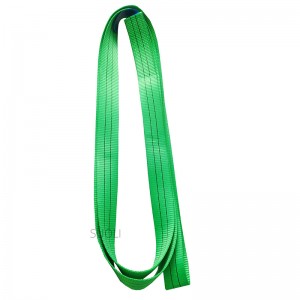Webbing Sling Belt supplier to enhance rust prevention performance of pressed steel wire rope can be used as raw material when used in damp or open air workplace.
Apart from the wear of the layer steel wire, the metal is gradually broken due to metal fatigue caused by repeated bending when bypassing the hook and the hanging object. Therefore, the ratio of the hook or the hanging object to the diameter of the pressing wire rope is an important factor determining the service life of the Webbing Sling Belt supplier.
3 Pressing steel wire rope is mainly used in lifting, pulling and other transportation requiring high strength rope, in the process of use is strictly prohibited to stand under the suspended object or pass on the object.
The Webbing Sling Belt supplier braided the joint-free wire rope by special process through the special winding equipment. The Belt Webbing supplier is characterized by soft rope body and many lifting points, which can meet the requirements of small lifting space and high load. It is suitable for the special needs of large hoisting in transformers, shipbuilding, special machinery and various environments
The breaking load is different for different sub-rope specifications, and the breaking load can be calculated according to the wire rope structure required by customers. The minimum breaking force of wire rope without joint is 6 times of working load. Processing range: φ10mm – φ570mm
Inserting wire rope is divided into manual inserting wire rope and machine inserting wire rope, can complete the processing of φ190mm less than all wire rope, product length control error can be accurate to mm, to meet the special hoisting in various fields, and contract the non-standard design of inserting wire rope, according to user needs for special design, production. The breaking load of the braided steel wire harness is 5 times of the working load.
Webbing Sling Belt supplier manually inserting and braiding wire rope
(1) This method provides a wire rope connecting device (commonly known as hook head) equipped with a sleeve ring by manually inserting six strands of wire rope with interactive twist of fiber rope core or wire rope core.
(2) After five times of interspersing, the five times of interspersing can be composed of three times of whole root interspersing and two times of reduced interspersing. All connectors should be opposite to the twist direction of the wire rope; Except for the first group, the ends of all the rope strands in the other groups should be opposite to the twisting direction of the steel wire.
③ Interspersion should be carried out in a cross way of upper and lower.
(4) If the wire rope has a fiber core, the rope core should go through completely with the first end of the first group of interspersed, and then cut off the exposed rope core. If the strand has a fiber core, the strand core should remain in the original strand.
If the wire rope has an independent wire core, the core should be divided into three parts. They are: — two strands, — two strands, — two strands with its core. Three interleaved end inserts should be used to weave the three sections and pass only through the three complete inserts.
⑥ If the wire rope has an independent wire core, the core should be folded inward in the first group of penetration, and fully inserted into the center of the insertion head for five complete penetration.
All the penetration should be fi rmly tightened to the center line of the penetration wire rope consistent with. In order to make the insertion smooth and round, they should be shaped with the appropriate tools to get them into place.
rmly tightened to the center line of the penetration wire rope consistent with. In order to make the insertion smooth and round, they should be shaped with the appropriate tools to get them into place.
⑧ the use of the ring should be matched with the wire rope diameter, ring card clamp to be reliable. The arrangement of wire rope and sheath ring should be shown in Figure 6-14, the initial method of manual insertion and braid. See Figure 5-15.
⑨ Burrs are inevitable at the insertion point. To avoid scratches on operators’ hands, use epoxy resin and other materials together with special soft plastic cylinder tools (such as mineral water bottles) to pour and seal the insertion point after inserting the hook end. Specific steps: Fix the soft plastic tubular tool at the insertion place with ropes or iron wires, place the wire rope upright, close the lower mouth of the tubular tool to prevent liquid from flowing out, and then pour the epoxy resin liquid into the tubular tool. Note: WHEN pouring, the liquid should be lower than the upper plane of the tool. After pouring, it should be placed upright for more than 24 hours so that the epoxy resin can solidify.
Wire rope is a safe and practical hoisting tool for lifting, shifting and carrying heavy objects. Its characteristics are high temperature resistance, wear resistance, easy to use, large bearing capacity, used in machinery, metallurgy, shipbuilding, petroleum, port and other industries.
Post time: Aug-18-2022
